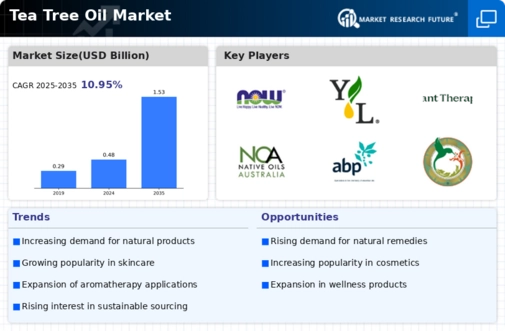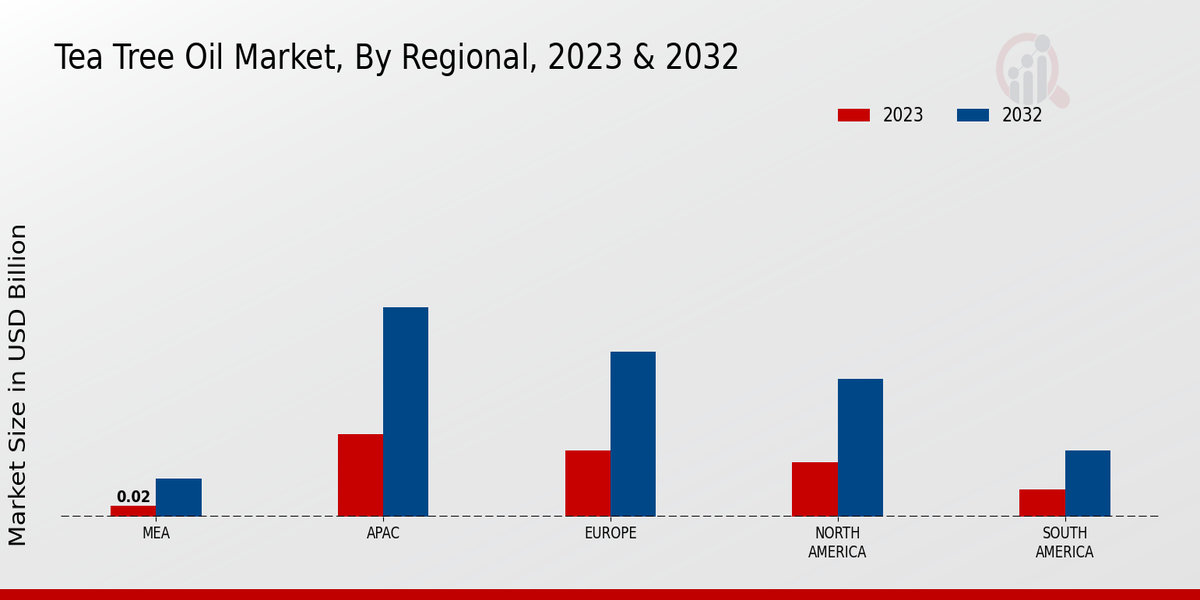Market Growth Projections
The Global Tea Tree Oil Market Industry is poised for substantial growth, with projections indicating a market size of 0.48 USD Billion in 2024 and an anticipated increase to 1.53 USD Billion by 2035. This growth trajectory suggests a compound annual growth rate of 11.03% from 2025 to 2035, reflecting the increasing demand for tea tree oil across various sectors. The expansion is driven by rising consumer awareness of natural products, the versatility of tea tree oil in personal care applications, and the influence of e-commerce platforms. These factors collectively indicate a promising future for the tea tree oil market.
Influence of E-commerce Platforms
The rise of e-commerce platforms has transformed the way consumers access tea tree oil products, significantly impacting the Global Tea Tree Oil Market Industry. Online retailing provides consumers with a wider selection of products and brands, facilitating easier access to tea tree oil. This trend is particularly beneficial for niche brands that may not have a strong presence in traditional retail outlets. The convenience of online shopping, coupled with the ability to compare products and read reviews, is likely to enhance consumer confidence in purchasing tea tree oil products. As e-commerce continues to grow, it is expected to play a pivotal role in driving market expansion.
Rising Demand for Natural Products
The increasing consumer preference for natural and organic products is a notable driver of the Global Tea Tree Oil Market Industry. As consumers become more health-conscious, they tend to favor products that are perceived as safe and free from synthetic chemicals. This trend is particularly evident in the personal care and cosmetics sectors, where tea tree oil is valued for its antibacterial and antifungal properties. The market is projected to reach 0.48 USD Billion in 2024, reflecting a growing inclination towards natural alternatives. This shift towards natural ingredients is likely to bolster the demand for tea tree oil in various applications, including skincare and haircare.
Growing Awareness of Health Benefits
Consumer awareness regarding the health benefits of tea tree oil is a crucial driver for the Global Tea Tree Oil Market Industry. Educational campaigns and increased access to information have led to a greater understanding of the oil's therapeutic properties, including its effectiveness in treating acne, dandruff, and other skin conditions. This heightened awareness is likely to stimulate demand, particularly among younger demographics who are more inclined to seek natural remedies. As a result, the market is expected to experience a compound annual growth rate of 11.03% from 2025 to 2035, indicating a robust future for tea tree oil products as consumers prioritize health and wellness.
Expanding Applications in Personal Care
The versatility of tea tree oil is a significant factor driving its adoption across various sectors, particularly in personal care. The Global Tea Tree Oil Market Industry benefits from its incorporation into a range of products, including shampoos, lotions, and acne treatments. The oil's antimicrobial properties make it a preferred ingredient for products targeting skin issues. As the market evolves, the demand for innovative formulations that include tea tree oil is expected to rise, further propelling market growth. The anticipated increase in product offerings is likely to contribute to the market's expansion, with projections indicating a growth trajectory that could see the market reach 1.53 USD Billion by 2035.
Regulatory Support for Natural Ingredients
Regulatory frameworks that support the use of natural ingredients in consumer products are likely to bolster the Global Tea Tree Oil Market Industry. Governments and health organizations are increasingly recognizing the benefits of natural substances, leading to favorable regulations that encourage their use in cosmetics and personal care items. This regulatory support can enhance consumer trust and stimulate demand for tea tree oil, as manufacturers seek to comply with standards that prioritize safety and efficacy. As the market adapts to these regulatory changes, it is anticipated that tea tree oil will gain further traction, contributing to its growth in various applications.










